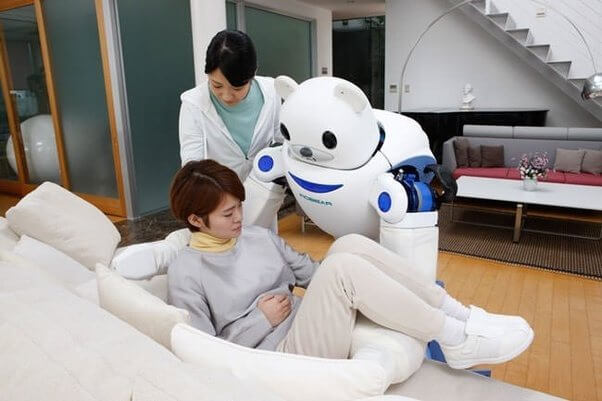How might care robots address supply and quality gaps in looking after our elderly in Singapore?
The number of Singapore residents aged 65 and above is expected to cross a million by 2030, and approximately 69,000 of them could be severely disabled. This means that they cannot perform three or more Activities of Daily Living (washing, feeding, dressing, toileting, mobility, transferring) by themselves.
This increases the demand for more intermediate and long-term care (ITLC) services, with home- and center-based services trending as the prevalent modes. Such services could be expensive, where the unsubsidized cost for home- and center-based services could reach a third of the monthly income for some households. As a result, many rely on domestic helpers for caregiving instead, which raises issues of competence and quality of care.
On the supply side, the total number of public-funded places across all three ITLC modes is estimated to be 33,200 by 2020, of which 6,200 are for center-based services. That is still far less than the 7,800 center-based referrals received by MOH in 2015. The supply of such ITLC services cannot be ramped up quickly. There is no systematic development of ITLC manpower, nor regulations on the quality of ITLC services by private operators. The sector employs about 11,000 workers, but the low-pay and long hours result in high turnovers. Reliance on foreign workers who are drawn to higher salaries in other countries further adds to the manpower challenges.
Quality home- and center-based ITLC services lead to better health management, higher quality of life, and reduce the burden on acute hospital care. The sub-optimal consumption and production of such services is an area of concern, and two issues stand out:
- increasing supply, and
- ensuring quality of care
Applications and Implications of Care Robots in ITLC
Care robots are defined as “machines that operate partly or completely autonomously with the aim of supporting older persons, their families, and care professionals in providing physical, cognitive, or emotional support”, and may enhance the supply and quality of ITLC services. They can be deployed in three areas:
- monitoring health and safety status,
- assistance with daily living, and
- companionship duties
Care robots interact with humans and learn autonomously from the data captured over time. The advanced ones collaborate as co-workers to humans, eg. robot nurses serving meals or taking health measurements.

Impact on Supply and ITLC Jobs
Care robots may displace certain jobs that are repetitive and done in a structured environment. However, the overall benefits of using robotics outweigh the displacement costs, where precious human time can be redirected to highly personalized touchpoints with the elderly. There is scope to retrain and redeploy displaced workers into other care-giving roles much needed in the sector.
Impact on Quality of Care
Through programming and machine learning, care robots deliver a consistent and trackable quality of service 24/7. They sidestep language barriers and reduce human carelessness and errors. For example, companion robots ensure timely and accurate medicine intake. They can also sync data with health systems for faster interventions by healthcare professionals.
Technology Limitations
Smart monitoring technologies are the most established for mainstream use, followed by companion robots. The least scalable are assistive robots, limited by the current state of Artificial General Intelligence and the Movarec paradox. For example, robot nurses in hospitals cannot yet navigate domestic environments independently. It is also not cost-efficient to use robots for low-level motor skills – the Bestic eating/feeding assistant costs USD6,200 sans meals. Ironically, the area of daily assistive care is also where ITLC services are most needed.
Challenges and Responses
There are several technological and ethical concerns with using care robots. Three of them are highlighted for interventions, whether by the public, private, or people sector –
- affordability and distribution,
- data security and privacy, and
- safety and liability
Affordability and Distribution
Cutting-edge assistive technology requires high capital costs, and are better deployed at centres than personal homes – a Hal-5 cybernics rehabilitation centre costs USD200,000 to set up. In an open market, only the very rich can afford it. A good solution would ensure adequate distribution of new technologies and access by those in need. Robotic services also have to be priced right so as to shift preferences away from unskilled domestic helpers.
Data Security and Privacy
Elderly users are typically less-informed about cybersecurity risks, and the 24/7 presence of monitoring robots and devices raises concerns about leaked data, unauthorized usage, and privacy intrusion. One of the useful measures was the launch of the new Cybersecurity Labelling Scheme to protect home smart devices.
We also need a regulatory framework (and enabling systems and processes) that stitches together different health systems, robotics platforms, and databases, and governs what is collected and access rights.
Safety and Liability
As care robots learn autonomously, we may lose sight of what they process and how they decide on actions. There are also many grey areas around blame attribution and liability for accidents between humans and robots. Since safety is a top priority in healthcare, it is important to go beyond the current risk classification for medical devices to develop comprehensive guidelines for various scenarios.
The Future of Care is Robo-enabled
The demand-supply mismatch in ITLC home- and center-based services will widen as our population ages. Care robots offer an opportunity to redesign work and shift workers to roles requiring high levels of human touch and empathy. However, widespread adoption is hampered by technological limitations, high costs, and cheaper care-giver alternatives. Further work is needed to create a sustainable robot ecosystem that delivers accessible and secure healthcare – but the challenge is exciting!
This article was written by Phei Sunn (sim.phei.sunn@gmail.com), with editorial inputs by Rovik Robert.








